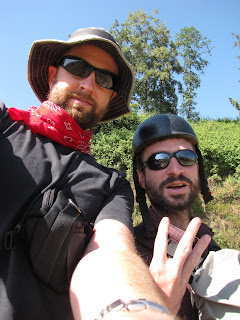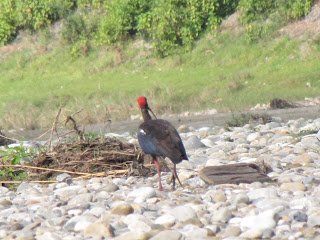A stupa is a concentration of blessed and sacred objects, contained within a structure in an auspicious place.
 As Buddhists, two of the most effective practices we can engage in on the path to Enlightenment are to accumulate merit and to purify obscurations. A stupa is an ideal setting to effectively engage in both of these activities. In Chatral Rinpoche’s A Brief Summary of the Benefits of Building, Circumambulating, Prostrating to, and Making Aspiration Prayers at a Stupa, he quotes the Buddha as saying,
As Buddhists, two of the most effective practices we can engage in on the path to Enlightenment are to accumulate merit and to purify obscurations. A stupa is an ideal setting to effectively engage in both of these activities. In Chatral Rinpoche’s A Brief Summary of the Benefits of Building, Circumambulating, Prostrating to, and Making Aspiration Prayers at a Stupa, he quotes the Buddha as saying,
“A stupa (is) the vajra essence of all Tathagatas (Enlightened Ones)…(A stupa is) consecrated by the secret essence of all the mantras of the Tathagatas…Whoever pays reverence and honors (a stupa) will eventually achieve the unexcelled and completely perfect state of enlightenment…All Tathagatas will bless the entire area that surrounds the place the stupa has been built in.”
 Wouldn’t it be wonderful if we had such a powerful monument to our highest potential here in the United States─a stupa as awe-inspiring as the great Boudhanath Stupa in Nepal? (above) Well, fortunately, there is a collection of people from around the world with pure compassionate motivation working on just that─the Maha Bodhivastu Stupa in the beautiful Hudson Valley of New York. (model on the right) Best of all, we have the incredibly fortuitous opportunity to help build this
Wouldn’t it be wonderful if we had such a powerful monument to our highest potential here in the United States─a stupa as awe-inspiring as the great Boudhanath Stupa in Nepal? (above) Well, fortunately, there is a collection of people from around the world with pure compassionate motivation working on just that─the Maha Bodhivastu Stupa in the beautiful Hudson Valley of New York. (model on the right) Best of all, we have the incredibly fortuitous opportunity to help build this
 As Buddhists, two of the most effective practices we can engage in on the path to Enlightenment are to accumulate merit and to purify obscurations. A stupa is an ideal setting to effectively engage in both of these activities. In Chatral Rinpoche’s A Brief Summary of the Benefits of Building, Circumambulating, Prostrating to, and Making Aspiration Prayers at a Stupa, he quotes the Buddha as saying,
As Buddhists, two of the most effective practices we can engage in on the path to Enlightenment are to accumulate merit and to purify obscurations. A stupa is an ideal setting to effectively engage in both of these activities. In Chatral Rinpoche’s A Brief Summary of the Benefits of Building, Circumambulating, Prostrating to, and Making Aspiration Prayers at a Stupa, he quotes the Buddha as saying,“A stupa (is) the vajra essence of all Tathagatas (Enlightened Ones)…(A stupa is) consecrated by the secret essence of all the mantras of the Tathagatas…Whoever pays reverence and honors (a stupa) will eventually achieve the unexcelled and completely perfect state of enlightenment…All Tathagatas will bless the entire area that surrounds the place the stupa has been built in.”
 Wouldn’t it be wonderful if we had such a powerful monument to our highest potential here in the United States─a stupa as awe-inspiring as the great Boudhanath Stupa in Nepal? (above) Well, fortunately, there is a collection of people from around the world with pure compassionate motivation working on just that─the Maha Bodhivastu Stupa in the beautiful Hudson Valley of New York. (model on the right) Best of all, we have the incredibly fortuitous opportunity to help build this
Wouldn’t it be wonderful if we had such a powerful monument to our highest potential here in the United States─a stupa as awe-inspiring as the great Boudhanath Stupa in Nepal? (above) Well, fortunately, there is a collection of people from around the world with pure compassionate motivation working on just that─the Maha Bodhivastu Stupa in the beautiful Hudson Valley of New York. (model on the right) Best of all, we have the incredibly fortuitous opportunity to help build this
stupa ourselves! Chatral Rinpoche quotes the Buddha as saying,
“If you make a stupa with your own hands, you will be able to purify your body even if you have committed…inexpiable sins.”
Engaging in the virtuous activity of building or supporting the construction of a stupa will also create enormous amounts of merit, which can propel us forward on the path to Enlightenment. The Maha Bodhivastu Stupa is prophesized by the high Oracle of Bhutan, Druk Chokyong Tsimar as a sacred structure that will benefit countless beings at this crucial moment in world history. The project is supported by many holy beings around the world. I strongly encourage you to join us in building it. The Stupa will be a focal point for our collective efforts to restore peace and harmony on the earth.
To learn more, please visit www.bodhivastu.org.
For more on Chatral Rinpoche’s teachings, please visit www.compassionateaction.info.
“If you make a stupa with your own hands, you will be able to purify your body even if you have committed…inexpiable sins.”
Engaging in the virtuous activity of building or supporting the construction of a stupa will also create enormous amounts of merit, which can propel us forward on the path to Enlightenment. The Maha Bodhivastu Stupa is prophesized by the high Oracle of Bhutan, Druk Chokyong Tsimar as a sacred structure that will benefit countless beings at this crucial moment in world history. The project is supported by many holy beings around the world. I strongly encourage you to join us in building it. The Stupa will be a focal point for our collective efforts to restore peace and harmony on the earth.
To learn more, please visit www.bodhivastu.org.
For more on Chatral Rinpoche’s teachings, please visit www.compassionateaction.info.









































